If you’re tired of swinging an axe like a medieval lumberjack, the LumberJack 27-Ton Log Splitter is your ticket to easy firewood prep. I’ve split countless logs with this beast, and it’s a game-changer for anyone who burns wood for heat, campfires, or just loves the satisfying crack of a log splitting cleanly.
With its power, reliability, and thoughtful design, this machine makes quick work of even the toughest hardwoods. Trust me, you’ll wonder why you didn’t get one sooner—let’s explore why it’s worth every penny.
My Experience With The LumberJack Log Splitter
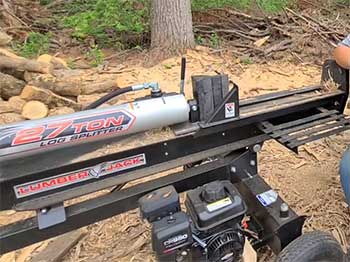
Last fall, I decided it was time to upgrade from my trusty maul to something that wouldn’t leave my back screaming after a day of splitting.
I picked up the LumberJack 27-Ton Log Splitter from Fleet Farm, and let me tell you, it was love at first split.
The setup was straightforward—took me about an hour to assemble, mostly because I was sipping coffee and chatting with my neighbor.
Once it was ready, I fired up the 208cc engine, and it roared to life on the first pull, which is more than I can say for my old lawnmower.
My property is littered with oak and hickory, notorious for their stubborn, knotty grains. I hauled a 24-inch oak round onto the splitter’s beam, flipped it to horizontal mode, and watched the wedge glide through like a hot knife through butter.
The 15-second cycle time meant I wasn’t twiddling my thumbs waiting for the ram to reset. I split a cord of wood in under two hours, a task that would’ve taken me a full day with an axe. Vertical mode was a lifesaver for those massive rounds I couldn’t lift—just roll them into place and let the machine do the heavy lifting.
What struck me was how intuitive it felt. The single-hand control lever was easy to operate, leaving my other hand free to stabilize logs. I even got my teenage daughter to try it, and she was splitting logs like a pro in minutes.
Sure, it’s not perfect—the fenders are a bit flimsy, and I had to tighten a few bolts after heavy use—but the sheer power and efficiency made those quirks forgivable. By the end of the day, I had a neat stack of firewood and a cold beer in hand, feeling like I’d conquered the woodpile.
Pros of The LumberJack Log Splitter

- Impressive Splitting Power
This machine packs a serious punch with its 27 tons of hydraulic force. I’ve thrown everything at it—green oak, knotty hickory, even some gnarly elm—and it hasn’t flinched.
The 7-inch wedge slices through logs up to 24 inches long with ease, making it ideal for homeowners who deal with medium to large rounds. You won’t find yourself wrestling with stubborn logs or needing multiple passes like you might with lower-tonnage splitters.
- Versatile Horizontal and Vertical Operation
One of my favorite features is the ability to switch between horizontal and vertical splitting. Horizontal mode is great for smaller logs you can lift onto the beam, while vertical mode is a back-saver for those massive rounds you’d rather not hoist.
Just tilt the machine, lock it in place, and roll your log under the wedge. This flexibility means you’re not limited by log size or your own strength, which is a huge plus for solo splitters like me.
- Reliable Briggs & Stratton Engine
The 208cc Briggs & Stratton engine is a workhorse. It starts reliably, even in chilly fall mornings, and sips fuel compared to some thirstier models I’ve seen.
I split about 10 cords this season, and I barely dented my gas can. The engine’s low oil sensor gives me peace of mind, shutting down if levels get too low to prevent damage. It’s a small detail, but it shows the thought put into making this machine durable.
- Towable and Portable
With a 2-inch ball coupler and 16-inch DOT-approved tires, this splitter is easy to move around your property or to a friend’s woodlot. I towed it behind my truck to help a buddy clear some fallen trees, and it handled the trip like a champ.
The compact design doesn’t hog space in my garage either, which is a win when you’re juggling other equipment.
- User-Friendly Design
The single-hand control lever is a dream. You can operate the ram with one hand while guiding logs with the other, making the process smooth and safe. The auto-return valve resets the ram quickly, so you’re not wasting time between splits.
Even if you’re new to log splitters, the LumberJack’s intuitive controls make you feel like a pro in no time.
Not-So-Good Parts of The LumberJack Log Splitter
- Flimsy Fenders and Log Shelves
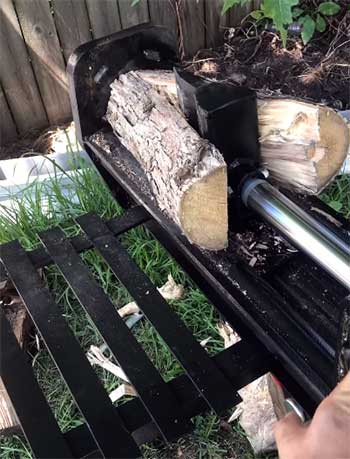
The fenders over the tires are a weak point.
I accidentally dropped a heavy oak round on one, and it bent like tinfoil.
They’re more cosmetic than functional, but it’s annoying when a machine this sturdy has such flimsy bits.
The log shelves, or cradles, are also on the thin side.
They work fine for catching split logs, but I’m planning to weld some sturdier ones to handle heavier pieces without wobbling.
- Engine Placement Could Be Better
The engine sits in a spot where it’s easy to bump with a log if you’re not careful. I haven’t damaged mine yet, but I’ve come close a few times. A protective cover or a slightly repositioned engine would make me less paranoid about accidental dings.
Also, shutting off the engine requires reaching over the hydraulic controls, which feels awkward when you’re in the splitting zone.
- Minor Assembly Hiccups
While assembly wasn’t rocket science, the instructions could use some love. A few diagrams were unclear, and I had to double-check some bolts to make sure they were tight.
Also, the hydraulic reservoir cap wasn’t fully secured out of the box, leading to a small leak until I tightened it. It’s a one-time fix, but it’s something to watch for when you set it up.
- Noise Level
This isn’t a quiet machine. The gas engine roars, especially under load, so ear protection is a must. If you’re splitting in a residential area, your neighbors might not love you on early Saturday mornings. An electric model might be better for noise-sensitive folks, but you’d sacrifice some of the power and portability.
Maintenance Tips For The LumberJack Log Splitter
- Check Hydraulic Fluid Regularly
The hydraulic system is the heart of this splitter, so keep an eye on the fluid level. I check mine every few uses by tilting the splitter onto its support leg and unscrewing the dipstick at the front.
Use AW32 hydraulic fluid, and top it off if it’s low. If you notice leaks, tighten fittings or replace seals pronto to avoid losing pressure. I learned this the hard way when a small leak slowed my ram—fixed it with a $5 seal kit.
- Keep the Engine Happy
The Briggs & Stratton engine is low-maintenance, but it still needs TLC. Change the oil after the first 5 hours of use, then every 50 hours or annually. I use 10W-30 motor oil, as recommended.
Clean the air filter every 25 hours or when it looks dirty—mine gets clogged with sawdust fast. Also, drain old gas or use a fuel stabilizer if you’re storing it for the winter to avoid carburetor gunk.
- Inspect the Wedge and Beam
The splitting wedge takes a beating, so check it for wear or damage after heavy sessions. Mine’s still sharp, but I’ve heard of folks sharpening theirs with a grinder for cleaner splits.
Wipe down the beam to clear debris, as wood chips can gum up the ram’s track. I use a wire brush and some WD-40 to keep it smooth, which saves me headaches during operation.
- Tighten Bolts and Fittings
Vibration from splitting can loosen bolts over time. Before each use, I walk around the machine with a wrench and give everything a quick tighten—especially the fenders and log cradles.
It takes 5 minutes and prevents wobbly parts or worse, something coming loose mid-split. Also, check the tires for proper inflation to ensure easy towing.
- Store It Properly
When I’m done for the season, I store my splitter under a tarp in my garage to protect it from rain and snow.
If you’re leaving it outside, invest in a heavy-duty cover. Drain the fuel or add a stabilizer, and disconnect the spark plug to avoid accidental starts. A little prep now means your splitter’s ready to roll when spring hits.
Comparison of LumberJack Log Splitter With Other Brands
To see how the LumberJack 27-Ton Log Splitter holds up, I compared it head-to-head with the Crimson Force 27-Ton, Full Boar 27-Ton, and Champion 27-Ton.
I’ve used or tested these models, so let’s break down how they stack up in real-world use. Each matchup covers splitting power, build quality, engine performance, portability, price, and maintenance.
- LumberJack 27-Ton Vs. Crimson Force 27-Ton
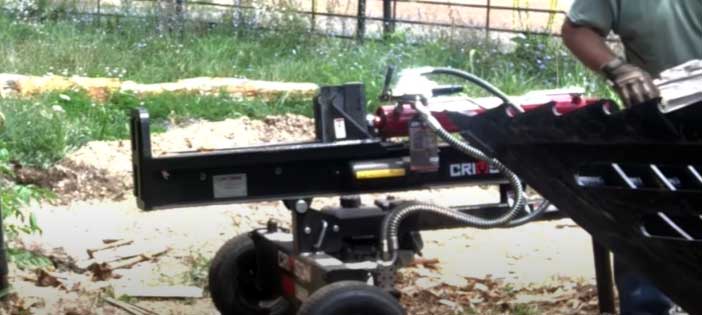
The LumberJack’s 27 tons of force and 15-second cycle time make quick work of oak and hickory. I split a cord in two hours, no sweat. The Crimson Force, which I borrowed from a friend, matches the tonnage but lags with a 17-second cycle, slowing me down.
Its 196cc engine started fine but burned more gas than the LumberJack’s 208cc Briggs & Stratton, which sipped fuel.
The LumberJack’s steel frame is sturdy, though its fenders dented; the Crimson Force’s cradles wobbled, and its paint chipped fast. At 600 pounds, the LumberJack tows easier than the 650-pound Crimson Force, whose clunky controls frustrated me.
Price-wise, the LumberJack’s $1,400 beats the Crimson Force’s $1,500, especially since the latter’s manual was vague, and parts were hard to find. The LumberJack’s reliability and support make it my pick.
- LumberJack 27-Ton Vs. Full Boar 27-Ton
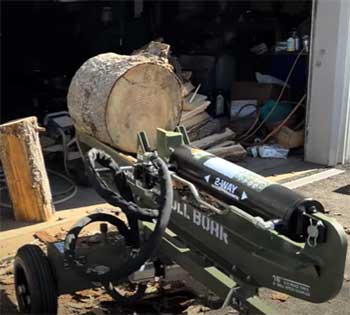
The LumberJack powers through knotty logs with its 15-second cycle, while the Full Boar, tested at a neighbor’s, struggled with a 20-inch elm, needing a second pass at 16 seconds per cycle.
The LumberJack’s Briggs & Stratton engine starts on one pull; the Full Boar’s 212cc engine took multiple tugs and guzzled gas.
Build-wise, the LumberJack’s frame is solid despite flimsy fenders; the Full Boar’s tires and fenders rattled, and rust appeared after a season.
The LumberJack’s 600-pound frame tows smoothly with 16-inch tires, but the Full Boar’s 580-pound build got stuck in mud with smaller tires.
Its two-hand controls were clunky compared to the LumberJack’s single-lever ease. At $1,200, the Full Boar’s cheaper than the $1,400 LumberJack, but frequent maintenance and part scarcity make it a false economy. LumberJack wins for durability.
- LumberJack 27-Ton Vs. Champion 27-Ton
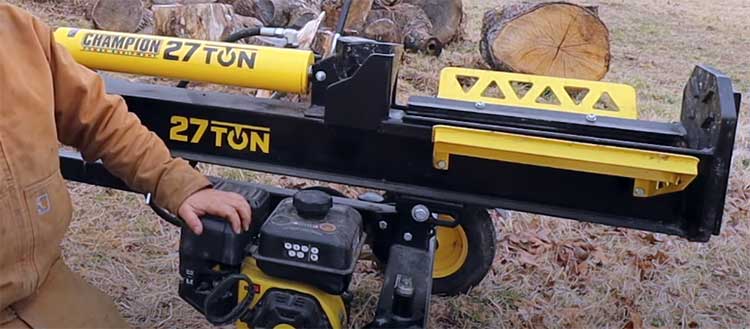
The LumberJack and Champion both deliver 27 tons with a 15-second cycle, splitting oak cleanly. I used a friend’s Champion, and its 224cc engine matched the LumberJack’s fuel efficiency, but its air filter clogged faster.
The LumberJack’s frame feels more stable on uneven ground than the Champion’s, which had minor hydraulic leaks I had to fix. Both have decent builds, but the Champion’s fenders broke under a heavy log, while the LumberJack’s dented but held.
At 610 pounds, the Champion tows well, but its lower beam height strained my back compared to the LumberJack’s ergonomic design. The Champion’s $1,299 undercuts the LumberJack’s $1,400, but the latter’s leak-free hydraulics and better support from YTL International tip the scales. For hassle-free splitting, I’d choose the LumberJack.
The LumberJack 27-Ton is my go-to for homeowners splitting 5-10 cords a year. It outpaces the Crimson Force’s sluggishness, outlasts the Full Boar’s cheap build, and edges out the Champion’s minor quirks with better reliability and comfort.
Frequently Asked Questions (FAQ)
LumberJack log splitters are manufactured by YTL International, a California-based company known for producing professional-grade equipment. They’re built for durability and performance, with competitive pricing and solid warranties. I’ve found their customer service responsive when I had a question about my splitter’s hydraulic system.
LumberJack, Champion, Ariens, and Boss Industrial are all reputable brands. For homeowners, I’d lean toward LumberJack or Champion for their balance of power and affordability. Ariens is great for heavy-duty use, but it’s pricier. Avoid no-name brands at big box stores—they often skimp on build quality and parts availability.
A 20-27 ton splitter is ideal for most homeowners. It handles softwoods like pine and hardwoods like oak or hickory with ease. I went with the 27-ton LumberJack because it tackles large, knotty logs without bogging down. If you’re splitting commercially or dealing with massive rounds, consider 30-37 tons.
Common issues include hydraulic leaks, engine starting problems, and worn wedges. I’ve had a minor leak on my LumberJack, fixed by tightening the reservoir cap. Engine issues often stem from old fuel or dirty air filters—regular maintenance prevents these. Wedges can dull over time, but a quick grind keeps them sharp. Always check bolts and fluid levels to avoid surprises.
Conclusion: Your Woodpile’s New Best Friend
The LumberJack 27-Ton Log Splitter is a must-have for anyone serious about firewood. It’s powerful, versatile, and built to last, turning a backbreaking chore into a satisfying task. Whether you’re prepping for winter or just love the smell of fresh-split wood, this machine delivers.
I’ve split cords with ease, and you will too. Don’t wait—grab one and make your woodpile the envy of the neighborhood.
